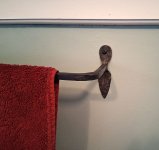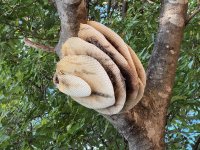You are using an out of date browser. It may not display this or other websites correctly.
You should upgrade or use an alternative browser.
You should upgrade or use an alternative browser.
Biggest Hive I've Ever Seen
- Thread starter Eric Patterson
- Start date
What type of bees makes a nest like that? Or has the paper disintegrated?My hunch is the hive was active last year. Glad there was nobody home because we were bush hogging below it.
View attachment 68781
View attachment 68782
Pretty sure it is a yellow jacket nest. Nest is probably a better word than hive.
Steve Sanford
Well-known member
Good morning, Eric~Pretty sure it is a yellow jacket nest. Nest is probably a better word than hive.
I have a photo like that - somewhere... I found the hive in the winter, in western NY. A beekeeper friend assured me it was the work of Honey Bees. I have forgotten the explanation, but I believe it happens when a hive that has been relocating gets "caught short" - and has not found a suitable cavity - or maybe the queen just prefers shade trees.
Here in the northeast, all the Yellowjacket nests I have found were grey and papery. Yours looks like the waxy honeycomb typical of Honey Bees - and quite edible.
Here is a good source:
https://extension.missouri.edu/publications/m403

So, no real danger from this species. The ones we worry about hereabouts are Bald-faced Hornets and Yellowjackets. The Paper Wasps and Mud Daubers are common but mild-mannered. The Hornets build big paper nests, enclosed, and often hanging from trees or intertwined amongst stems. I will not do any bush-hogging during the warmer months - especially now when the colonies are at their largest. As my tractor does not have an enclosed cabin, I wait until after the first killing frosts.
Our Yellowjackets usually nest in the ground (also in buildings). When inspecting a freshwater wetland many years ago, a colleague inadvertently stepped too close to a ground nest. She was stung 28 times I believe. By dumb luck, I found a nearby hospital - which happened to be a world-class heart hospital. I had to drag her the last 30 feet into the ER - and the doctors had to bring her back to life. Her airways had closed. She recovered completely - but still carries an epi-pen.
So - a great find for any naturalist!
All the best,
SJS
Nasty buggersPretty sure it is a yellow jacket nest. Nest is probably a better word than hive.
So it appears Eric's is honeybees. Yum.Good morning, Eric~
I have a photo like that - somewhere... I found the hive in the winter, in western NY. A beekeeper friend assured me it was the work of Honey Bees. I have forgotten the explanation, but I believe it happens when a hive that has been relocating gets "caught short" - and has not found a suitable cavity - or maybe the queen just prefers shade trees.
Here in the northeast, all the Yellowjacket nests I have found were grey and papery. Yours looks like the waxy honeycomb typical of Honey Bees - and quite edible.
Here is a good source:
https://extension.missouri.edu/publications/m403
View attachment 68788
So, no real danger from this species. The ones we worry about hereabouts are Bald-faced Hornets and Yellowjackets. The Paper Wasps and Mud Daubers are common but mild-mannered. The Hornets build big paper nests, enclosed, and often hanging from trees or intertwined amongst stems. I will not do any bush-hogging during the warmer months - especially now when the colonies are at their largest. As my tractor does not have an enclosed cabin, I wait until after the first killing frosts.
Our Yellowjackets usually nest in the ground (also in buildings). When inspecting a freshwater wetland many years ago, a colleague inadvertently stepped too close to a ground nest. She was stung 28 times I believe. By dumb luck, I found a nearby hospital - which happened to be a world-class heart hospital. I had to drag her the last 30 feet into the ER - and the doctors had to bring her back to life. Her airways had closed. She recovered completely - but still carries an epi-pen.
So - a great find for any naturalist!
All the best,
SJS
I hate those damn yellow jackets and hornets. Domestic terrorists. The hornets have a preferred hive location on the side of our house. I take it down every fall, new ones take residence in spring.
Steve
The texture did make me think of honey bees but with no surrounding structure I didn't see a place for them to store honey. The stacked layers, like pancakes, of the nest looks exactly the same as yellow jacket nests, which are sometimes above ground. But as you mention the paper is missing. I'm just glad there wasn't a swarm. It was about 10' above ground next to where we parked our vehicles and were bush hogging.
The texture did make me think of honey bees but with no surrounding structure I didn't see a place for them to store honey. The stacked layers, like pancakes, of the nest looks exactly the same as yellow jacket nests, which are sometimes above ground. But as you mention the paper is missing. I'm just glad there wasn't a swarm. It was about 10' above ground next to where we parked our vehicles and were bush hogging.
Carl
Good idea! How would you do that? Double boiler and break the nest in pieces and drop in the pot and fish back out what doesn't melt?
Good idea! How would you do that? Double boiler and break the nest in pieces and drop in the pot and fish back out what doesn't melt?
If i remember right (had an old timer I used to hunt with MANY MANY years ago who did the bee thing) he would boil and pour through cheese cloth to filter it.Carl
Good idea! How would you do that? Double boiler and break the nest in pieces and drop in the pot and fish back out what doesn't melt?
William
I went and watches some YT vids and that is how many do it.
I went and watches some YT vids and that is how many do it.
Yes, do this. About 45 years ago, my grandpa and I kept bees. At first, he melted wax with a double boiler or slow cooker, then strained it. Later, he built a solar melter that let the sun do the work. He would load it with scraps of comb or wax and just let it run.I was thinking honey bees too.
Harvest the comb for the wax!
He and my dad would mix a little mineral oil with the melted wax and pour it into baby food jars. Once it set, the softened wax was perfect for dipping large penny nails, making them easier to drive into framing or hard wood. My grandpa also used the wax for candles or as a waterproofing coat for wood and other things.
Steve Sanford
Well-known member
Anthony~Yes, do this. About 45 years ago, my grandpa and I kept bees. At first, he melted wax with a double boiler or slow cooker, then strained it. Later, he built a solar melter that let the sun do the work. He would load it with scraps of comb or wax and just let it run.
He and my dad would mix a little mineral oil with the melted wax and pour it into baby food jars. Once it set, the softened wax was perfect for dipping large penny nails, making them easier to drive into framing or hard wood. My grandpa also used the wax for candles or as a waterproofing coat for wood and other things.
I have kept beeswax in my shop for a long time - for a variety of lubrication purposes - including many in the NDR category...
Most recently, my neighbor made (forged) us a pair of extra-long towel bars. He suggested beeswax as a finish. I left the bars - and the beeswax - in the sun to warm. I then rubbed on a heavy coat - and buffed it once everything had cooled and hardened. So far so good.....

All the best,
SJS
Capt Rich Geminski
Well-known member
I love watching a blacksmith or knife maker work. Mitch Yates, famous master muzzle loader gun smith, does a blacksmith exibition at the Springs blacksmith shop.


